
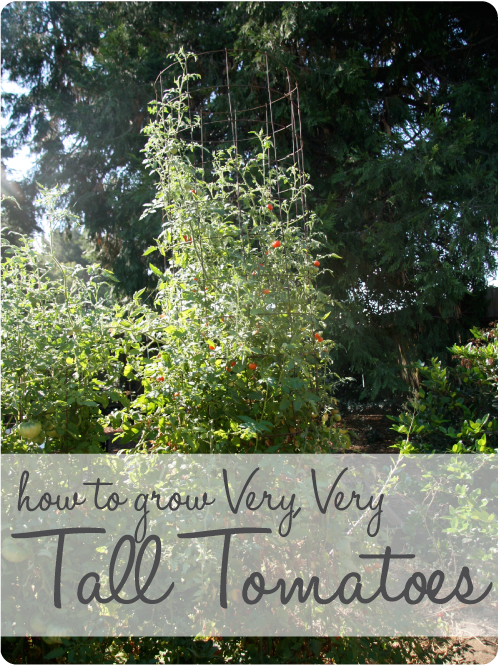
Growing tomatoes is such a staple for gardens in many climates. They are relatively easy to grow and there are endless ways to use tomatoes. If you have a small yard though, it may be hard to grow as many tomato plants as you’d like, which is why you need to get a little creative. Instead of more plants, you want the few plants you do have to grow as tall as you can. Over the years, we’ve tried lots of different methods for growing the most productive tomato plants, from simply sticking the plants into the ground, to using that fancy red plastic mulch (which doesn’t work at all). This method is our absolute favorite method because it really gets both water and oxygen to the roots which is essential for a thriving tomato plant. This method is adapted to our needs from the book, How to Grow World Record Tomatoes: A Guinness Champion Reveals His All-Organic Secrets
(an excellent read). Grown this way we easily get 6 foot – 10 foot tomato plants each year, organically of course!
First we bought a few yards of drainage pipe (like PVC pipe with 1/2″ holes drilled into it) and cut it into 18″ lengths. Then after tilling the beds, we dig 15″ deep holes with the post hole digger about 18″ on either side of where the tomato plant will be planted. Because we tend to plant our tomatoes in a long row, we dig a series of holes every 3 feet along that row.
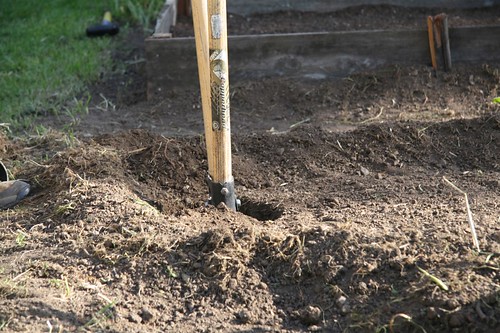
Place a length of pipe into the hole.
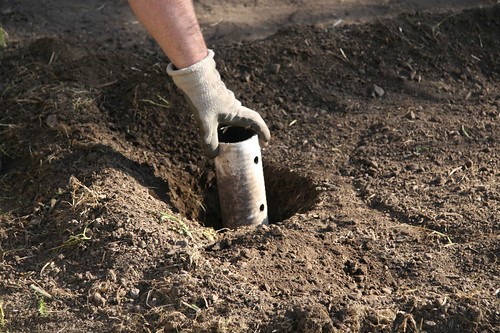
Fill the hole back up with dirt (but not in the pipe!). You should have a couple extra inches of pipe sticking up to allow some room for mulching around without it falling into the pipe.

Because we expect large tomato plants every year, store bought tomato cages just don’t provide enough support. We custom built our tomato cages using 6″ concrete wire that comes in 5′ widths (learn all about it in our How to Support Tomato Plants post). We bend this into a circle and wire the edges together. We even have a few cages that we zip tied together to get twice as high for our larger 10 foot plants. This wire fencing provides ample support and has holes big enough to fit our hands through to pick those beautiful red tomatoes.
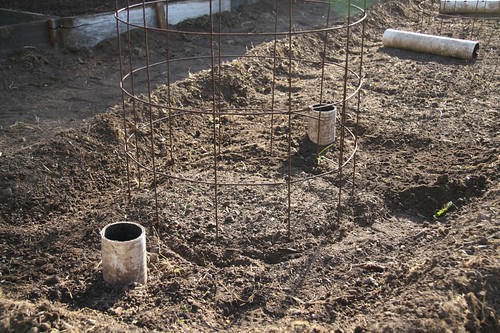
When the tomato plants are planted we water them deeply about twice a week, depending on the weather. We water both in a circle around the base of the plants, but also put the hose down into the pipe and let it fill up with water. The water in the pipe slowly drains down deep into the soil encouraging the roots to grown down deep as well, providing the plant a strong base to grow strong and tall. About once a month we’ll water them well with fish emulsion as well for nourishment.
Try out this method this summer. You won’t believe how getting the water and oxygen down to the roots that deep affects the plants. You will have your neighbors in awe with how tall & productive your tomato plants will be. Let me know how this method works for you.
Update: This post was originally written in 2008 and updated in 2014. Along those years we spent two years just simply planting the tomatoes in the ground with out the drainage pipes because we were in a time crunch in spring. Boy did we pay for it those years. We’ve since returned back to our pipe/tomato pairing and we’ve had one of our most successful tomato crops in years.


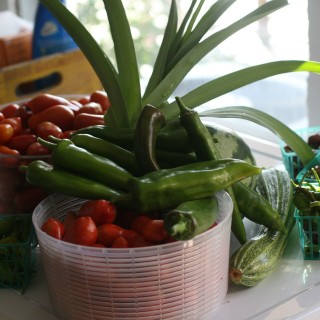





Great tip for the tomato’s!!
Great idea for the tomato’s!
This is impressive. I hope you post photos occasionally through the season. I can’t wait to see them.
First let me say that I have been enjoying your blog. I also live in Sonoma County and enjoy reading about what my fellow local gardeners are up to. I really like what you’ve done with your tomato plants. I think I might give the buried drainage pipe a shot in my garden this year. i haven’t got my plants in the ground yet. Hopefully this weekend. I look forward to watching you garden progress.
Sarah
Very cool. Not a tip I’ve seen before. I’ve been hoping to set up a soaker hose system for my garden (which is fairly small.. only 21X21), but this would be a very simple way to get crazy water to the tomatoes right at the root. Definitely going to give this a try.
That is a great suggestion. I think I will try it this year. Can you tell me about how many inches away from the tomato plant stem you place the two pipes?
Hi Rick, we place them roughly 18 inches away from the stems. We put them in between each plant in our tomato row.
This is so great. I love the pipe idea. We usually bury coffee cans or barring that, yogurt containers with the bottoms cut off. Then we water into those. Usually 2 containers for each plant. It does really make a difference, that and a heavy mulch. Do you use a fertilizer mid-season at all? Liquid kelp or anything like that? I’ve neglected that this year, but still seem to be doing not bad. I think we’d have had more fruit if I was to have fertilized though.
Hi,
I put in deep pipes for my dwarf fruit trees and am watering them with rinse water from the kitchen which I am amazed to discover I have an abundance of, about 2 buckets per time working in the kitchen. After thinking I wouldn’t have enough water this way I now believe I have a surfeit an am anxious to put in deep pipes for my tomatoes and possible zucchini and other fruiting plants.
My question is, how often do you water your plants? I pour the water down the pipe and it promptly disappears and I have no idea how moist it’s staying down there around the tree roots.
I have thought about getting a moisture meter but thought I’d ask you what your experience has been with general frequency of watering with this method. I don’t want to overwater.
Thanks
Hi Windsor Cindy,
We watch how the tomatoes are doing and water based on that. We’ve found that with our soil and climate that doing a deep watering once a week is all we need to do. We do fill up the pipes a few times during that watering so we give them plenty of water. I love your idea of using kitchen water scraps to water with. I was going to use watering cans to hold water scraps, but buckets would be much better. It’s amazing how all that water adds up, isn’t it? Thanks for the comment.
Question what exactly is water scraps?
hi, my question is how do you guys fertilize these tomato plants, with liquid fertilizer, down the pipes or on top,around the plant or how? I put in the pipes last night, and wired it up, just 1 plant in the ground now though, and 9 others in 5 gallon pots cherry tomatoes.
thanks rt
Hi rt. We don’t fertilize them at all. We condition the soil well before we put them in and then they are on their own. We do add compost around them mid season, but other than that we just give them tough love and water.
I implemented the PVC pipe watering suggestion and have had the greatest crop of tomatoes in 20 years!!!
I live in ND where the summer was very cool but despite the weather, I watered
every other day and have never seen anything like this years crop. And, I night add, not blight, worms, disease of any kind.
Thank you.
CR
I’m so glad to hear CR!
Вечер добрый. У меня есть вопрос по поводу контекстной рекламы на Вашем сайте. Вам не доводилось сталкиваться со случаями блокирования аккаунта администрацией гугла за типа “накрутку”? Как защитить себя в этом случае?
Hello! I live in New Zealand and as I’m semi-disabled I grow tomatoes in plastic buckets.Your set-up looks really great.I water in two ways. Either by hand with hose, or with plastic lemonade bottles.Just fill with water, put tissue in top of bottle, and stuff into bucket.It releases water very slowly.I’m going to try your idea next year.
I will try your watering tubes. I found the concrete reinforcement fence is perfect for tomatoes. I have used it for years and I also use the fence to grow melons on – it works great!
This is wonderful!! We are trying it tomorrow with the tomatoes. We live in Argentina so it is spring. My husband made mini ones to put in the hanging flower baskets. They work great! Thank you for the info!!
Looks like it would be an awesome way of getting nutrients to the roots as well
Looks awesome! Interestingly, I know two people who sewar byt he red mulch. Haven’t tried it myself.
Reblogged this on bewitchingdragon and commented:
Great Idea
Hi love the idea for the tomatoes.I have one question 18 ” pcp pipe i/2″ holes down the pipe how many and how far apart?
If you read the whole article and replies :
asonomagarden
April 24, 2008 at 4:38 am
Hi Rick, we place them roughly 18 inches away from the stems. We put them in between each plant in our tomato row.
If you reread:
Mary Thornburg
February 5, 2012 at 2:15 pm
Hi love the idea for the tomatoes.I have one question 18 ” pcp pipe i/2″ holes down the pipe how many and how far apart?
I believe she is asking how many 1/2 inch holes and how many down the pipe. I’m curious myself.
Excellent idea! Good for fruit trees when first planted?
I have concrete block raised gardens and I am anxious to try this!!! I find that with the raised gardens, many times the water runs down the sides and out the bottom. I’m sure this will slow down the water and make it dispurse more evenly. It appears the pipe is about a 3″ dia. wouldn’t you think?
Thanks for sharing the great idea!!!!
Cool tips…I’m wondering if logic follows, I could plant a tomato at the top of one of those strawberry pots, then the water would go in each level as I watered those? I don’t know if Tomatoes and Strawberries play nice though…hmm…maybe little onions…
Just wondering how this could work in Oregon, where it rains 1/2 the summer and we have heavy clay soil? We usually do not have to water at all.
I realize that I am 4 years late to the party (thank you Google search) but I was wondering if you have any pictures of what the plants look like once they’ve grown in there. I’m a gardening beginner and I have some plants that I bought already mostly grown (so I’d have SOMETHING this year) and I seemed to damage them by trying to get them into the store bought cages. I’m a visual person, so any photos you have would be awesome.
What would happen if you planted 3 or 4 plants on the outside of you wire support and tied them to the wire for support. Put lawn clippings inside the wire as a mulch ( keep moist) and let it form compost over the summer and winter. add another 18″ tube for the additional plants. you loose a lot of growing space with 1 plant on the inside of the wire.
Please DON’T use PVC (polyvinyl chloride) – the production of PVC creates and releases one of the most toxic chemicals – dioxin. PVC products can leak harmful additives during use and when they are burned or BURIED.
http://www.greenpeace.org/international/en/campaigns/toxics/polyvinyl-chloride/
Glad to see I’m not the only one who had that instant thought. I’ve been pondering alternatives, as the function presented here is fantastic; the materials used are worrisome. I can’t think of something easy to find that would be made of inert food grade plastic and have this shape. Probably a better choice would be found in a plumbing supply store, utilizing polyethylene (PEX) pieces.
One year we used empty 2 litre pop bottles, upside down with the bottom cut off. We had a much better crop of tomatoes that year, probably due to the deeper watering. I hope the pop bottles didn’t break down into dangerous chemicals, though…
PVC pipe contains no plasticizers like all the flexible Vinyl materials. It is all approved for potable water. I doesn’t break down in use and also a slime coating forms on the surface that is like a protective coating. It is not PVC touching the water after initial use. Most new homes in the U.S.A. have PVC piping. Lack of plasticizers is what makes the PVC rigid and usable as grow tubes.
Lynda, do you have any alternative ideas to using the pipes?
I got so excited about the pipe idea but my mind automatically went to planting the tomatoes into the pipes so the gopher guys would not demolish and drag the plants down and under. I am certain this method of watering is very effective. I am still on the gopher problem, the only way I can keep chasing them from one place to an other is by flooding them out from under cherry trees and other wonderful plants. I really do not want to harm the critters but it is a constant battle here in the Sierra Foothills in No California.
The two folksy remedies for gophers that I remember my grandmother using were placing whirlygigs or pinwheels in the garden (supposedly the little critters do not like the vibration) and the second one is putting human hair in the runs (the human scent deters them–she had a beautician friend who gladly supplied her with plenty of hair).
use colorine tablets for the pool. Break up a round 3″ tablet into little pieces and place 2 or 3 in the hole as you water for the gopher. They will leave asap.
FIRST HEARD OF THIS METHOD BEING USED IN THE DESERT TO SAVE WATER…WILL TRY….WONT HURT TO ADD BIOCHAR TO HOLD WATER AND NUTRIENTS ALSO…ROY
Elisabeth, on the gopher problem, we have very heavy gophers or moles in all the yards around us but not a one in our yard. We have 2 (indoor) daschunds and just the sound of them in the yard for a short time every day drives the undergrown critters away. The hair tip also works. Hair acts as an itching powder that they can’t stand so they pack up and move next door too. Happy hunting.
planted my tomato plants today. I used black pvc pipe. I have not had a garden in about 30 years. I really hope this works because my husband is a disbeliever. Gotta show him he’s wrong
I suggest using septic system drain field pipe…the holes are already made in pvc pipe. Previously Ihave used the pipe in my compost bins for air circulation. I am replacing all of my fruit trees dead or dying from recent years of drought (NW TX) and now will definitely use it for each new tree…as well as my tomatoes. I have a rain harvest system and this idea will dovetail beautifully. Thank you for the great tip.
READ YOUR COMMENT…5 WAYS TO FIGHT DROUTH…1.ROCK DUST 2.BIOCHAR .3. HUGELKULTUR. 4. MYCORRHIZA (OR NEW FOREST SOIL) 5. MUST USE COMPOST WITH THESE WAYS…CALLED THE OKLAHOMA WAY OF GARDENING…HOPE THIS HELPS OR GIVES SOME IDEAS….ROY
I thought about an easy way to keep the soil from falling in to these pipes -just cover them with pantyhose! You can even pour water from the top through the panty hose, but putting the pipe into a “leg” then burying it would be a simple fix for looser soils. What do you think?
That’s certainly worth trying…I think I will!
Very excited about this method of watering. My garden will be twice it’s normal size this year. This maybe a silly question but i am assuming you use this watering technique with all your plants?
This seems like a Great Idea. I am definitely going to try this. I was going to plant them this weekend so this was perfect timing
brilliant! but, as I was about to do this in my new raised bed I learned that PVC pipes can leach vinyl chloride, a known carcinogen – so you do not want to use that in the garden!!
To be safe use a UPVC, copper or galvanized steel pipe =)
Early-Era PVC
“Early-era” PVC refers to PVC pipe manufactured prior to 1977. According to the U.S. Environmental Protection Agency (EPA), early-era PVC can leach VCM into drinking water to levels that exceed the maximum contaminant level of 2 micrograms per liter of water.
PVC Today
Starting in 1977, PVC pipe manufacturers drastically improved their manufacturing processes to reduce VCM levels in manufactured pipe. Some PVC pipe is manufactured to a specification called “NSF-61” or “NSF-PW,” specifically for use in applications involving drinking water.
Read more: PVC Pipes and Drinking Safety | eHow.com http://www.ehow.com/facts_6155868_pvc-pipes-drinking-safety.html#ixzz2RVFh2mO7
Reblogged this on prizmgirl.
I have done the same thing for my patio tomato plants but with plastic water bottles. I cut the end off, close the mouth piece with screw top, poke holes all around and bury them on either side of the plants. My bushes have never looked or grown better. Saw it on a Pin on Pinterest. If I had the land you do I would do what you are doing, but for now my potted plants feed all of us and our extended family!
I thought of this years ago, but dirt kept filling up the pipe. I found DeepDrip.com and they had a membrane inside that stops the dirt from filling the tube. You might try rocks inside and that may slow the flow of dirt from going inside the tube.
I can’t pin the photos, maybe because they are on Flickr?
possibly, though others have pinned these images. If you want you could search for asonomagarden in pinterest and the image will come up. then you could repin that.
Wow that seems so easy and such a great wsy to get water to the roots. Thanks for all the awesome advice on gardening, this will definitely be my best garden ever.
You can also do this cheaply by taking the plastic pots people get when they by buying plants from the store, or purchasing them, digging a hole and placing them in the hole. The pots should already have holes to allow the water to drain. They don’t go down 18 inches but sill are good for up to 12 inches. Put some balanced fertilizer in them before watering for even healthier plants. I have had excellent results doing this.
to keep soil from filling the pipe, slip an old knee-high hose over the the pipe before putting it into the soil.
I know that your way to water tomatoes works well. We have a device that is very similar called “Deep Drip Watering Stakes” which saturate the soil at a deep level. It works well with drip systems by coming off the mainline with a 1/4″ spagetti line and stick it down the tube with an emitter on the end. they’re great for trees too. You can see them on dripworks.com.
That’s a great idea, to have an emitter go down into the tube. We’ve become big fans of your store in the past three years Leon!
Many years a OKLA Farmer just dug a hole 3 ft deep with post hole diggers/filled with straw & watered every 10 days. Huge abdundent Tomatoes.
Great ideas, I have heard of using PVC pipe placed at the correct intervals and popping the seed right into it, The light will attract the plant to grow up the tube and anything outside of it will be treated as a weed.
I love your pages of tips and tricks and sure could use this method of watering here in the desert.
we are growing our tomatoes in a row the last two years and it has worked great my question is do you just water in the pipes ? we are now watering in a trough around the plants .
So do I put water in the pipe and water that way? We don’t get rain here in the Summer so I assume I would put water in the pipe that way?
Love the pipe trick! My husband has been making giant tomato cages like yours for years, works great for lots of crops, but especially supportive for heavy tomato vines. Another way to get awesome tomato plants is to put your transplants deep into the ground, right up to the bottom set of leaves. Dig the hole the depth of the plant to the last set of leaves. If you soil is hard to work, go as deep as you can and gently lay the root ball on it’s side and coil the stem around the hole. Hold the remainder of the plant upright in the center of the hole and start filling with soil. This gives a super strong root system and a. Bumper crop of tomatoes! Try it!
I put 2-liter soda bottles in the ground between my plants. I poke holes in the bottom of the bottle, bury it with just the neck exposed, and fill the bottle with water. I also bury crushed eggshells in the hole I plant the tomatoes in to give them a calcium boost.
Also remember to plant your tomatoes much deeper than they are as starters. I take off the bottom 2 or 3 branches (to the 2nd or 3rd leaf node), depending how big your plant is, and plant to that new depth. More roots will grow along the planted part of the stem giving the plant access to more water also. I only do this with tomatoes as most plants need to be planted at their original soil level.
I’m going to try this this year how big around are the cages or how long a piece of fence
Nice Post, I like simple jobs that requires no long readings and have plenty of simple pictures to help guide you along the way, I have a bad tendency to ignore instructions or labels because most comes with complex words like PH levels in soils,fertilizers and so on, so I am the man who breaks the rules in gardening altogether and just use my brains and hands to adventure into my own styles and ideas, the what if…is where I travel, what if I dont follow their instructions will I still have success, will i succeed in making bonsai trees not in the traditional Japanese styles, though I respect others ideas and styles I am simply simple, dig a hole fight the chickens away from it, lightly water the soil and toss in the seeds and bury and just wait, 90% of the time I have success in being simple, all this high scale time consuming techniques just does not fit my time slot and waste of time, besides I rather learn from my own mistakes than try and read and avoid them. I have plenty of PVC ppipes lingering in my yard and thanks to your accepted simple idea I am going to put them to use, Thank You your lovely post. always The rule Breaker.
3 questions:
1) seems like the fencing all comes in 4′ rolls these days (home depot etc) – where did you get 5′? I did find a coated variety – http://www.homedepot.com/p/YARDGARD-5-ft-x-50-ft-14-Gauge-Vinyl-Galvanized-Welded-Wire-308354B/202024094?N=5yc1vZc3lp
2) Did you cut the bottom ring of horizontal wiring off of the fencing so that you had “legs” to insert into the dirt? or did you just bury the fencing in the ground as-is?
3) How did you connect the 10′ fencing ? I assume you stacked two 5′ separate pieces of fencing?
thanks for the great tips. i came here for fencing help and will also try the watering tubes 😉
Brian
Hi Brian, We actually use 6″ concrete wire which comes in 5′ widths for the cages and we secure those to the ground by inserting a 4′ piece of rebar into the ground and tying it to the cage. To put two cages together to make a 5′ one we use zip ties. I’ll do an updated post about it next week!